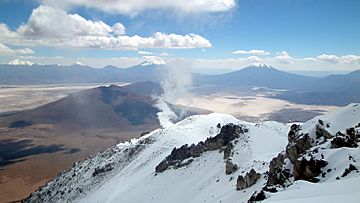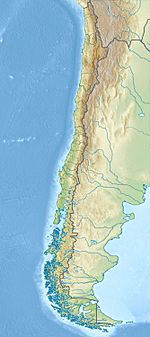Palpana facts for kids
Quick facts for kids Palpana |
|
|---|---|

The volcano is visible in the upper center portion of the photo, which was taken from the summit of Ollagüe volcano. Salar de Ascotán (left) and Salar de Carcote (right) are also visible in the photo.
|
|
| Highest point | |
| Prominence | 1,947 m (6,388 ft) |
| Parent peak | Aucanquilcha |
| Listing | Ultra |
| Geography | |
| Parent range | Andes |
| Climbing | |
| First ascent | 13 October 1977 - José Ambrus and Jaime Sepúlveda (Chile) |
Palpana is a tall volcano located in the Andes mountains of Chile. It reaches a height of about 6,040 meters (19,816 feet) above sea level. This makes it one of the highest peaks in the region.
Palpana is part of a chain of volcanoes that stretches for about 50 kilometers (31 miles). It sits between the Upper Loa River basin and the Salar de Ascotán basin. The volcano rises from a flat area made of volcanic rock, which is about 3,700 meters (12,139 feet) high.
Contents
Volcano Features
The top of Palpana has a large crater, which is about 1.3 by 1.8 kilometers (0.8 by 1.1 miles) wide. Inside this crater, you can see younger lava domes. These are dome-shaped mounds formed by thick, slow-moving lava. There's also a cluster of these lava domes in the middle of the volcano, creating a flat area about 4.7 square kilometers (1.8 square miles) in size.
The volcano is made up of different kinds of rocks, including basalt and andesite. These rocks were formed from lava flows and other volcanic materials like scoria (a type of volcanic rock with many air bubbles) and pumice (a very light, porous volcanic rock). The sides of the volcano are quite steep, with an average slope of 26 degrees near the top.
One side of the volcano, the western flank, once collapsed. This created a large scar, about 2.9 kilometers (1.8 miles) wide and 5.9 kilometers (3.7 miles) long. The material from this collapse spread out at the base of the volcano.
How Old is Palpana?
Scientists believe Palpana is a relatively young volcano, possibly only 1 to 2 million years old. However, there are no signs of eruptions happening after the last ice age. Over time, erosion has carved deep ridges into the volcano's sides.
Studies of the rocks on Palpana's southeastern side show that some lavas and scoria are even older, dating back about 3.65 to 3.81 million years.
Ice and Water
During past ice ages, glaciers covered parts of Palpana. You can still see signs of these old glaciers, called moraines, on the mountain. The lowest moraines are found at about 4,200 meters (13,780 feet) high on the southern side.
Today, there are "block glaciers" on the mountain. These are slow-moving masses of rock and ice. One of them is located at about 5,300 meters (17,388 feet).
Palpana is also an important source of water for the Loa River. In the past, water from Palpana was even sent through pipelines to the city of Antofagasta. The mountain has some vegetation, covering about 20-25% of its surface.
Cultural Importance
The local people who live around Palpana, often herders, consider the mountain sacred and worship it. Evidence of an ancient sanctuary has been found on its very summit, showing its long-standing cultural significance.
See also
 In Spanish: Volcán Palpana para niños
In Spanish: Volcán Palpana para niños
- Cerro Chela
- Cerro de las Cuevas
- List of mountains in the Andes
- List of Ultras of South America
Images for kids



